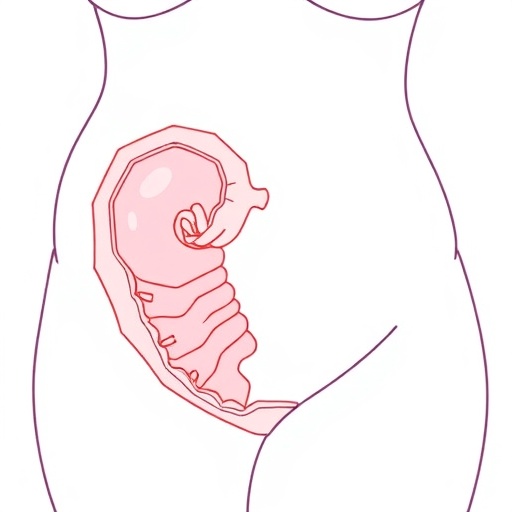A groundbreaking systematic review published in the latest volume of Oncoscience has unveiled critical insights into a rare and highly aggressive subset of uterine cancers characterized by trophoblastic differentiation and secretion of the hormone beta-human chorionic gonadotropin (β-hCG). Spearheaded by researchers Mishu Mangla and Seetu Palo from the All India Institute of Medical Sciences, Bibinagar, this extensive analysis consolidates global evidence on these elusive malignancies, shedding light on their clinical behavior, prognosis, and potential therapeutic avenues.
Trophoblastic differentiation marks a notable deviation in tumor histopathology, where somatic cancer cells acquire characteristics reminiscent of placental trophoblasts. These cells are known for their unique capacity to secrete β-hCG, a hormone typically involved in pregnancy. This ectopic expression in uterine corpus tumors signals a divergence in tumor biology and correlates with aggressive clinical phenotypes. The review systematically examined 40 documented cases, revealing that such tumors, albeit rare, exhibit an alarming propensity for early dissemination and therapeutic resistance.
Patients presenting with these β-hCG-secreting uterine malignancies predominantly fall into the post-menopausal demographic, with clinical presentations frequently marked by abnormal uterine bleeding or post-menopausal hemorrhage. Concomitant comorbidities such as obesity, diabetes mellitus, and essential hypertension were commonly observed, highlighting a potential interplay between metabolic syndrome components and tumor pathogenesis.
Histologically, these tumors tend to exhibit high-grade, poorly differentiated cellular architecture with conspicuous trophoblastic features. The review’s survival analysis underscored grim outcomes; nearly 50% of affected individuals succumbed within 10 months post-diagnosis. Moreover, only about 30% achieved a disease-free state following treatment protocols, underscoring the refractory nature of these malignancies to conventional therapeutic modalities.
The pervasive early metastasis patterns, especially pulmonary involvement, raise critical concerns regarding current staging and diagnostic accuracies. Even cases classified as early-stage at initial presentation frequently displayed microscopic or radiologic evidence of widespread metastasis, emphasizing a dire need for advanced diagnostic tools capable of detecting occult disease spread.
Treatment paradigms remain unscripted owing to the rarity and heterogeneity of these tumors. Nevertheless, the systematic review highlights the promise shown by an EMACO chemotherapy regimen—which includes etoposide, methotrexate, actinomycin-D, cyclophosphamide, and vincristine—traditionally applied in managing gestational trophoblastic disease. Remarkably, all three cases administered EMACO as neoadjuvant therapy demonstrated sustained survival, contrasting starkly with a patient treated with the BEP regimen (bleomycin, etoposide, platinum) who experienced cerebral metastasis and succumbed within six months.
β-hCG remains a pivotal biomarker, not only reflecting hormonal aberrancies but also serving as a harbinger of poor prognosis in this neoplastic context. The ectopic production of β-hCG appears to potentiate tumor aggressiveness, potentially through autocrine and paracrine signaling pathways that promote invasion and metastasis. Recognizing elevated β-hCG levels pre-operatively could thus have significant clinical implications in risk stratification and therapeutic decision-making.
This comprehensive review advocates for routine measurement of serum β-hCG in all suspected cases of endometrial carcinoma and uterine sarcomas. Furthermore, it suggests that pathological examination using immunohistochemical staining for β-hCG should become standard practice when elevated hormone levels are detected. Such protocols could pave the way for early identification of this tumoral phenotype and timely intervention.
The resistance profile of these tumors to conventional chemotherapy and radiotherapy further complicates their management. The review underscores the pressing urgency to explore novel agents and targeted therapies, as conventional treatments frequently fail to induce sustained remission. Treatment individualization guided by molecular profiling and hormonal status assessment emerges as a critical necessity.
Notably, the study draws attention to the crucial role of early disease staging as the only consistent variable correlated with improved survival outcomes. However, the traditional staging systems may inadequately capture these tumors’ aggressive biological behavior, warranting development of refined staging criteria and molecular markers that account for trophoblastic differentiation and β-hCG secretion.
The rarity of these tumors poses challenges for clinicians, who must often navigate treatment paradigms in the absence of standardized guidelines. This knowledge synthesis acts as an invaluable resource, providing data-driven insights that may inform clinical judgment and inspire further research to optimize patient management strategies.
By highlighting the distinctive pathophysiology and clinical trajectory of β-hCG-secreting uterine malignancies, the review also encourages oncologists and pathologists to maintain heightened vigilance when evaluating uterine tumors exhibiting unusual trophoblastic features. These markers could potentially define a separate clinical entity requiring customized diagnostic and therapeutic approaches.
In conclusion, this landmark systematic review not only illuminates the natural history and grim prognosis associated with trophoblastic differentiation and β-hCG secretion in uterine cancers but also sparks critical discourse around diagnostic improvements and targeted treatment opportunities. The integration of hormonal assays and immunohistochemistry into routine clinical workflows alongside prospective research into EMACO and other promising regimens may ultimately reshape the therapeutic landscape for this challenging cancer subtype.
Subject of Research: Not applicable
Article Title: Prognostic significance of trophoblastic differentiation and β-hCG secretion in somatic malignancies of uterine corpus: A systematic review with survival analysis
News Publication Date: 4-Sep-2025
Web References: http://dx.doi.org/10.18632/oncoscience.625
Image Credits: © 2025 Mangla et al., distributed under CC BY 4.0
Keywords: cancer, choriocarcinomatous differentiation, endometrial carcinoma, human chorionic gonadotropin, leiomyosarcoma, prognosis, trophoblastic differentiation




